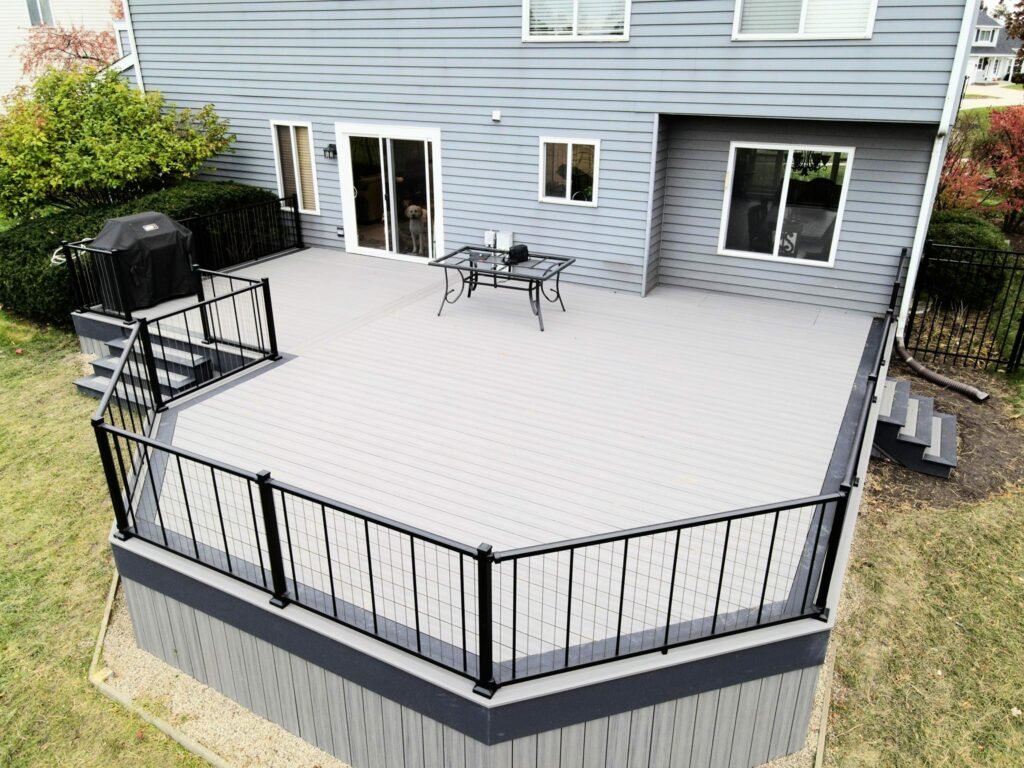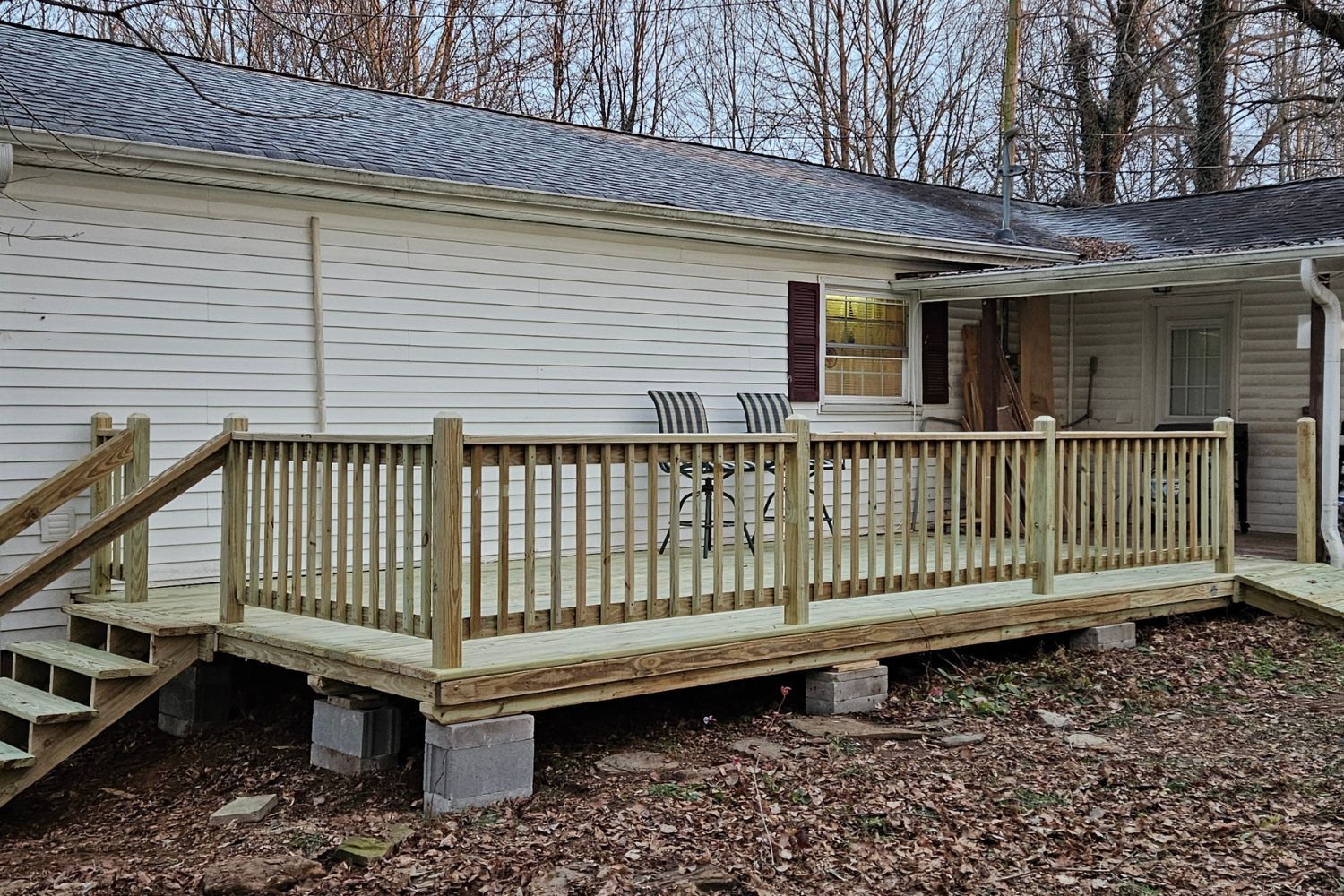Top 10 Tools Recommended by Wood Deck Builders Contractors Near Me for DIY Enthusiasts
Secret Considerations to Ensure Smooth Deck Setup on Your Building
When you're preparing to mount a deck on your residential or commercial property, a number of crucial factors to consider can make all the difference. You need to analyze your outdoor space and understand your particular demands. Picking the appropriate products is important for both longevity and aesthetics. And don't forget regional building regulations-- they're more vital than you may assume. Allow's discover what you must keep in mind to ensure a smooth installation process.
Examining Your Outdoor Area and Needs
How do you envision utilizing your outside room? Think of whether you desire a relaxing spot for family gatherings, a silent resort for reading, or a vibrant location for amusing friends. Analyze the design of your lawn-- consider the sunlight's course, existing trees, and any type of slopes that could impact your design. You'll additionally desire to examine neighborhood zoning legislations and HOA regulations to assure compliance with any kind of limitations.
Think about just how much upkeep you're willing to dedicate to, as this will certainly influence your design selections. By clearly specifying your vision and requires, you'll establish a strong foundation for your deck installation task, ensuring it enhances your outdoor experience and fits perfectly right into your way of living.
Picking the Right Products for Toughness and Visual Appeal
When it concerns picking materials for your deck, you wish to balance toughness with looks. Different material types can use distinct benefits, and the ideal layout can boost your exterior space. Let's explore your choices to locate the ideal fit for your needs.
Material Types Comparison
Choosing the right materials for your deck is essential, as it not only impacts the framework's durability however also its total visual appeal. Compound products mix wood fibers and plastic, offering resilience and low maintenance, though they can be more expensive. Light weight aluminum outdoor decking is unbelievably sturdy and resistant to weather, yet it may not match the typical timber appearance.
Visual Style Choices
While picking materials for your deck, it's crucial to balance looks and sturdiness. You want a deck that looks great yet additionally stands up to the aspects.
Don't ignore color and structure; picking a discolor or end up can boost your deck's visual allure. Integrate layout components like railings and lighting to match your selected materials. Inevitably, pick a design that mirrors your home's personality while guaranteeing your deck stays useful and resilient.
Comprehending Local Building Codes and Rules
Comprehending local building regulations and policies is crucial, as these policies confirm your deck is safe and certified. Before beginning your project, you'll intend to contact your regional structure department. They'll supply standards on materials, dimensions, and structural needs specific to your area. These codes frequently differ by location, so it's crucial to recognize the specific laws that relate to you.
You may need to obtain licenses before building and construction begins, which can consist of sending comprehensive plans of your deck. This process warranties your design meets security requirements and zoning laws. In addition, laws may determine setback ranges from building lines or existing frameworks.
Disregarding these codes can lead to expensive fines or the need for alterations later on. Take the time to research study and understand what's required in your area-- it'll save you migraines down the line and validate your deck is constructed to last.
Correct Website Preparation and Preparation
Prior to you start building your deck, you require to examine the ground conditions to assure a strong foundation. Planning the deck format is vital for making best use of space and capability, so take your time to design it thoughtfully. Do not fail to remember to get the required authorizations to keep everything certified with local guidelines.
Examining Ground Conditions
As you prepare for deck installation, reviewing ground problems is crucial to guarantee a steady and long-term framework. If the ground is unequal, consider leveling it to give a strong base for your deck. Analyze the proximity of neighboring structures, as this can influence your deck's design and safety.
Creating Deck Layout
With a solid foundation assessed, you can now focus on making your deck layout. Beginning by thinking about the purpose of your deck-- will it be for entertaining, stress-free, or perhaps both? Step your offered room and illustration a format that complements your home's design and landscape. Consider flow; assurance there suffices space for furniture and movement. Placement the deck to take full advantage of sunshine or color, depending upon your preference. Don't neglect to consider any existing functions, like trees or paths, that may influence your design. Think about the materials you'll make use of, as they can affect the total aesthetics. A well-planned format sets the phase for a deck that improves your residential property and meets your demands.
Getting Essential Licenses
Once you have actually chosen your deck layout, acquiring the needed permits is necessary to assure compliance with local policies. Beginning by contacting your local building department to recognize details requirements for your area. Some municipalities might have zoning legislations, problem needs, or elevation restrictions that you have to adhere to.
Collect the required papers like site strategies, architectural details, and in some cases also engineering records. Do not fail to remember to make up any property owner association guidelines if suitable.
Submitting your application precisely can save time and stay clear of prospective delays. Once you receive the authorizations, keep them handy during the setup process. In this manner, you'll ensure everything keeps above board and avoid any type of fines or concerns down the line.
Employing Qualified Professionals vs. DIY Installation
When deciding in between employing qualified specialists and taking on a do it yourself deck installation, you'll want to evaluate your abilities and resources versus the my explanation intricacy of the job. If you have experience use this link with carpentry and a solid understanding of local building ordinance, a DIY approach might save you cash. Think about the time and initiative needed.
On the other hand, working with specialists can ensure a high-quality installment. They have the knowledge, tools, and understanding to deal with unforeseen obstacles, which can conserve you from costly blunders. Furthermore, they can usually complete the task quicker than you could by yourself.
Eventually, consider your available time, degree of know-how, and the intricacies of your deck design. If the project feels overwhelming, investing in a qualified professional could offer peace of mind and a beautifully ended up deck that satisfies security standards.
Budgeting for Your Deck Project
Before diving into your deck job, it's essential to develop a realistic budget plan that covers all elements of the installation. Beginning by determining the products you wish to use-- timber, composite, or PVC-- each comes with various price factors. Factor in labor expenses if you're employing specialists, or consider the devices and materials needed for a DIY internet technique.
Don't forget to include licenses and evaluations, which can vary by location. It's smart to allot an added 10-15% for unanticipated expenditures that may emerge throughout the procedure.
Lastly, think of any type of additionals, like railings, lights, or furniture, that might boost your deck's capability and aesthetics. By developing a complete budget, you'll assure you not just stay on track economically but likewise develop the outside space you've pictured.
Upkeep and Treatment for Longevity
To ensure your deck remains in top condition for years to find, regular maintenance is important. Beginning by cleaning your deck a minimum of two times a year. Use a moderate soap and water solution to remove dust, particles, and mold and mildew. For wooden decks, consider using a timber cleaner and brightener to maintain the natural shade - custom deck builders company near me.

Additionally, maintain the area around your deck clear of fallen leaves and debris. This not just enhances visual appeals yet likewise protects against wetness build-up that can result in mold and mildew. By following these straightforward steps, you'll confirm your deck remains stunning and useful for years ahead.
Frequently Asked Concerns
What Is the most effective Season for Deck Setup?
The ideal period for deck installation is springtime or very early fall. Temperate weather condition makes it less complicated to work, guaranteeing materials stick correctly. And also, you'll enjoy your brand-new deck throughout the warmer months in advance.
How much time Does a Regular Deck Installation Take?
Deck installation generally takes one to 2 weeks, relying on dimension and complexity. You'll wish to consider weather and any type of needed authorizations, so intending in advance can aid simplify the process significantly.
Can I Set Up a Deck on a Sloped Yard?
Yes, you can install a deck on a sloped yard. You'll require to take into consideration progressing, proper assistance frameworks, and drain systems to ensure stability and safety. With mindful preparation, it can be a fulfilling task.

What Allows Are Required for Deck Setup?
You'll likely need a structure authorization for deck installation, depending upon neighborhood policies. composite deck builders austin tx near me. Contact your city or area to verify needs, as they can vary. Do not forget to make inquiries concerning zoning and security codes too
How Do I Protect My Deck From Climate Damages?
To secure your deck from climate damage, frequently use sealers, make use of weather-resistant products, and clean debris. Think about mounting a roof or awning, and check for wear to ensure durability versus rough problems.